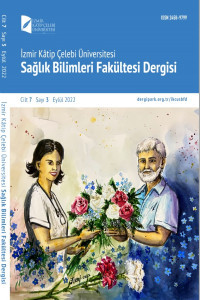Presenteeism: Hemşirelik Bakım Davranışlarını Etkileyen Bir Faktör
Amaç: Bu çalışmanın amacı hemşirelerin presenteeism durumlarının hemşirelik bakım davranışlarına etkisinin incelenmesidir.
Gereç ve Yöntem: Tanımlayıcı tipte olan bu araştırmanın verileri Mayıs-Ekim 2021 tarihleri arasında toplanmıştır. Araştırmaya katılmayı kabul eden ve aktif olarak çalışan 283 hemşire araştırmanın örneklemini oluşturmuştur. Veriler, kişisel bilgi formu, Stanford Presenteeism Ölçeği (SP-6) ve Bakım Davranışları Ölçeği-24 (BDÖ-24) kullanılarak toplanmıştır.
Bulgular: Hemşirelerin %63,6’sının haftalık çalışma saati 40 saatin üzerindedir ve %54,8’inin işte çalışırken yorulduğu belirlenmiştir. BDÖ-24 toplam puan ortalaması 4,8±0,9, SP-6 toplam puan ortalaması ise 20,4±4,8 olarak saptanmıştır. Meslek yılı >20 yıl olan hemşirelerin SP-6 puan ortalamaları meslek yılı
Anahtar Kelimeler:
presenteeism, Bakım davranışı, presenteeism, hemşirelik
Presenteeism: A Factor Affecting Nursing Care Behaviors
Objective: This study examines the effect of nurses' presenteeism status on nursing care behaviors.
Material and Method: The study is a descriptive study and data were collected between May and October 2021. The sample of the study consisted of 283 nurses who accepted to participate in the study, and who were working at the time of the data collection. Data were collected using personal information form, Stanford Presenteeism Scale (SP6), and Caring Behaviors Inventory-24 (CBI-24).
Results: It was determined that 63.6% of the nurses work more than 40 hours per week and 54.8% of them are tired while working at work. The mean score of the CBI-24 was 4.8±0.9, and the total mean score of the SP-6 was 20.4±4.8. SP-6 mean score of nurses with a professional experience of >20 years is statistically significantly lower than the group with a professional experience of
Keywords:
Care behavior, presenteeism, nursing,
___
- Karadağ S, Taşçı S. Kayseri devlet hastanesinde çalışan hemşirelerin verdiği hemşirelik bakımı ve bakımı etkileyen faktörler. EUJHS. 2005;14 (Ek Sayı: Hemşirelik Özel Sayısı): 13-21.
- Wu Y, Larrabee JH, Putman HP. Caring behaviors inventor: A reduction of the 42-item instrument. Nurs. Res. 2006;55(1):18-25.
- Kurşun Ş, Kanan N. Bakim Davranışlari Ölçeği-24’ün Türkçeye uyarlanması: Geçerlik ve güvenirlik çalışması. AHSBD. 2012;15(4):229- 235
- Rainbow JG, Dudding KM, Bethel C. A qualitative study describing nurses' experiences with presenteeism. J Nurs Adm. 2021;51(3):135- 140.
- Baysal İA, Baysal G, Aksu G, Aksu N. Presenteeism (işte varolmama sorunu) ile örgütsel bağlılık arasındaki ilişki: Adnan Menderes Üniversitesi akademik personeli üzerinde bir uygulama. Ejovoc. 2014;4(3):134-152.
- Rainbow JG, Steege LM. Presenteeism in nursing: An evolutionary concept analysis. Nurs Outlook. 2017;65(5):615-623.
- Arslaner E, Boylu Y. İş hayatında presenteeism: Otel işletmeleri açısından bir değerlendirme. İAD. 2015;7(4):123-36.
- Letvak SA, Ruhm CJ, Gupta SN. Nurses' presenteeism and its effects on self-reported quality of care and costs. AJN. 2012;112(2):30-38.
- Koopman C, Pelletier KR, Murray JF, Sharda CE, Berger ML, Turpin S. et al. Stanford Presenteeism Scale: Health status and employee productivity. JOEB, 2002;44(1):14-20.
- Brborović H, Brborović O, Brumen, V, et al. Are nurse presenteeism and patient safety culture associated: A cross-sectional study. Arh Hig Rada Toksikol. 2014;65(2).
- Fiorini LA, Griffiths A, Houdmont J. Reasons for presenteeism in nurses working in geriatric settings: A qualitative study. JHA. 2018;7(4):9-16.
- Rainbow JG. Presenteeism: Nurse perceptions and consequences. J Nurs Manag. 2019;27(7):1530-1537.
- Shan, G, Wang S, Wang W, Guo S, Li Y. Presenteeism in nurses: Prevalence, consequences, and causes from the perspectives of nurses and chief nurses. Fpsyt. 2021;11:1541.
- Homrich PHP, Dantas-Filho FF, Martins LL, Marcon ER. Presenteeism among health care workers: Literature review. Rev Bras Med Trab. 2020;18(1):97.
- Freeling, M, Rainbow JG, Chamberlain D. Painting a picture of nurse presenteeism: A multi-country integrative review. IJNS. 2020;109:103659.
- Rainbow JG, Drake DA, Steege LM. Nurse health, work environment, presenteeism and patient safety. WJNR. 2020;42(5):332-339.
- Şahan S, Yıldız A. Determining the relationship between presenteeism and organizational support in nursing. IJHSRP. 2020;5(3):306-314.
- Güneş S, Bayer, N, Bulut S. Hemşirelerde presenteeism davranışı: Bir özel hastane örneği. AvrasyaSBD. 2021;4(3):199-207.
- Lu L, PengHui SO, Lin Y, Cooper CL. Presenteeism and Health over time among Chinese employees: the moderating role of self-efficacy. Work Stress. 2014:28(2):165-178.
- Martinez LF, Ferreira, AI. Sick at work: Presenteeism among nurses in a portuguese public hospital. Stress Health, 2012;28(4):297-304.
- Mosteiro‐Díaz, MP, Baldonedo‐Mosteiro M, Borges E, Baptista T, Querios C, et al. Presenteeism in nurses: Comparative study of spanish, portuguese and brazilian nurses. INR. 2020;67(4):466-475.
- Arnold D. Determinants of the annual duration of sickness presenteeism: Empirical evidence from european data. Labour. 2016;30(2):198-212.
- Aysun K, Bayram Ş. Determining the level and cost of sickness presenteeism among hospital staff in Turkey. JOSE 2017;23(4),501-509.
- Li Y, Zhang J, Wang S, Guo S. The effect of presenteeism on productivity loss in nurses: the mediation of health and the moderation of general self-efficacy. Fpsyg.2019;10: 1745.
- Dalkılıç E, Seren AKH. İşte var olamama: Nedenleri ve sonuçları. JHNM. 2018;5(2):123-131.
- Pilette PC. Presenteeism in nursing: A clear and present danger to productivity. JONA.2005;35(6):300-303.
- Soper Daniel. Free Statistics Calculators. California; 2016. Available from: http://www.danielsoper.com/statcalc/.). [Internet]. 2021 Dec
- ISSN: 2458-9799
- Yayın Aralığı: Yılda 3 Sayı
- Başlangıç: 2016
- Yayıncı: İzmir Katip Çelebi Üniversitesi
Sayıdaki Diğer Makaleler
Şengül CAN, Ayşegül AKSOY GÖKMEN
Sabriye UÇAN YAMAÇ, Nurten TERKEŞ
İntrapartum Dönemde Sürekli Bakım ve Ebelerin Rolü
Ummahan YÜCEL, Belma TAŞ, Aysun BAŞGÜN
Oral Demir İlacının Akılcı Kullanımının Gebelikte Hemogram Düzeyine Etkisi
Zümrüt BİLGİN, Yeliz DOĞAN MERİH
Yaşlılarda Tele Hemşirelik Uygulamaları
Burcu AKPINAR SÖYLEMEZ, Ecem ÖZGÜL
Sağlık Bilimleri Öğrencilerinin Alzheimer Hastalığı ve Demansa Yönelik Bilgi ve Tutumları
Ahmet Raşit DEĞİRMENDERELİ, Kemal OSKAY, Şeyda TOPRAK ÇELENAY
